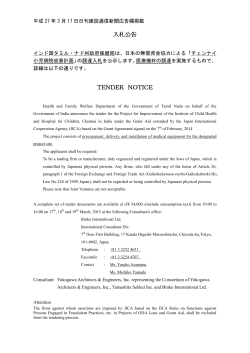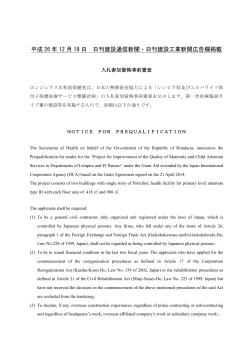
ããã¼ã«å°éã®å°éåã¨å»ºç©è¢«å®³! - æ±åå¤§å¦ ç½å®³ç§å¦å½éç 究æ
! ! MMI ! ! ! 2015.5.8! ! ! ! ! GDACS ! !USGS! ! ! ! ) VIII4IX! ! ! 5 ! JMA4MMI (nisee) g) Reinforced concrete frame with masonry, Type 1; 3 sto (USGS)! ! The distribution of building types was mapped by visual ob ! ! • with building inventory survey data, topographic maps an shown in Figure 7.7.1. ! PGA:!160!Gal! PGV:!95cm/s! :!5.0! !( 2 大 ↑ 揺 れ の 大 き さ ↓ 小 (USGS)! ! Figure 7.7.1 Classification Map showing Predominant (3) JICA,2002 短 ← 周期 → 長 (USGS)! Fragility Curves The second step in estimating damage to buildings 2006 relationship between damage ratio and ground acceler building. The graph showing this relationship is called th this study, fragility curves for buildings in the Kathmandu as shown in Table 7.7.1 and Figure 7.7.2. ! ! ! ! Existing and Calibrated Fragility C Type of Buildings ! • • • Table 7.7.1 JICA,2002 ! ! Stone (ST) Adobe (AD) Brick with mud mortar (BM) Well-built brick with mud mortar (BMW) Brick with cement or lime mortar (BC) RC frame with masonry of 4 stories or more (RC5) RC frame with masonry of 3 stories or less (RC3) Existing curve Prof. Arya UNDP A A to A+ B- to B B+ B to C1 C1 K5 C2 K3 - 79 - 1/ 1/ Figure 7.7.1 Classification Map showing Predominant Building Type (3) Fragility Curves ! The second step in estimating damage to buildings was to determine the ! ! relationship between damage ratio and ground acceleration for each type of building. The graph showing this relationship is called the “Fragility Curve”. In this study, fragility curves for buildings in the Kathmandu Valley were determined 160Gal→JICA(2002) as shown in Table 7.7.1 and Figure 7.7.2. 20430%? ! ! Table 7.7.1 Existing and Calibrated Fragility Curves Type of Buildings Stone (ST) Adobe (AD) Brick with mud mortar (BM) Well-built brick with mud mortar (BMW) Brick with cement or lime mortar (BC) RC frame with masonry of 4 stories or more (RC5) RC frame with masonry of 3 stories or less (RC3) Existing curve Prof. Arya UNDP A A to A+ B- to B B+ B to C1 C1 K5 C2 K3 JICA 2002 ! Fragility Curve for this Study Damage Rate Collapse Rate A++ B A++ B B B++ B++ C1 B++ C1 1/2[(K5)+(B++)] 1/4[(K5)+(B++)] 1/2[(K3)+(B++)] 1/4[(K3)+(B++)] ! ! ! 2000 2013 - 79 - JICA 2002 ( ! ! JMA 5 ! ! ! ! ! ! ! ! ! ! ! baidu
© Copyright 2025












